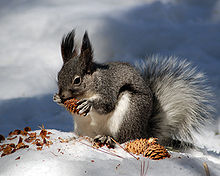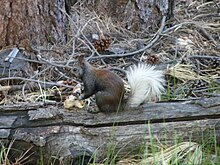Aberthörnchen
| Aberthörnchen | ||||||||||||
|---|---|---|---|---|---|---|---|---|---|---|---|---|

Aberthörnchen ( Sciurus aberti ) |
||||||||||||
| Systematics | ||||||||||||
|
||||||||||||
| Scientific name | ||||||||||||
| Sciurus aberti | ||||||||||||
| Woodhouse , 1853 |
The Aberthörnchen ( Sciurus aberti ) is a type of squirrel from the genus of the squirrel ( Sciurus ). It is found in the southern states of the United States and northwestern Mexico .
features
The Aberthörnchen reaches a head-torso length of about 26.0 to 27.5 centimeters, plus a tail that is about 20.8 to 22.1 centimeters long. The weight of the animals ranges from about 590 to 620 grams. The back fur of the animals is usually dark or steel gray to soot black, often with a reddish back band or a spot along the spine. The belly is white, the tail is steel gray and frosted white. The ears have clear tufts of hair that are particularly large in winter. Melanism is widespread within the species, and the kai squirrel as a subspecies also has a completely white tail.
distribution
The Aberthörnchen is found in the southern United States as well as northwestern Mexico. In the United States, the range is in the Rocky Mountains in southeastern Utah , the south and west of Colorado , the extreme southeast of Wyoming , western and central New Mexico and Arizona ; in some areas of these states the croissant was introduced after the fact. In Mexico, the species is found in the Sierra Madre Occidental in the states of Chihuahua , Durango and Sonora .
Way of life
The Aberthörnchen lives in relatively dense areas of coniferous forest stands with largely closed treetops, which essentially consist of yellow pines ( Pinus ponderosa ). It has long been assumed that the species is completely dependent on the occurrence of the yellow pines, but this has now been revised. The animals prefer heterogeneous and mixed-age pine stands. They are diurnal and mostly arboreal, but occasionally come to the ground to look for food. They feed mainly on seeds from the cones of the yellow pine and other pines ( Pinus ), firs ( Abies ) and Douglas fir ( Pseudotsuga menziesii ) as well as acorns . There are also other seeds, buds, mushrooms, insects and also bones. Unlike other squirrels, they do not collect or hoard food, but occasionally use the food stores of other species such as that of the common red squirrel ( Tamiasciurus hudsonicus ). A special adaptation is the use of bast , the tissue formed from the phloem below the tree bark, as an important source of food, especially in winter. The animals bite off twig ends 2 to 5 centimeters in length and peel off the bark in order to reach the Bast to come; the peeled twigs are thrown to the ground. For the digestion of the bast tissue, the Aberthörnchen have a slightly longer intestine than other croissants. The territories of the squirrels overlap strongly with the respective neighbors, while the activity areas with areas larger than 20 hectares are comparatively large and the males often have larger territories than the females. Communication between the animals is very limited; they mainly use high-pitched alarm tones when they are startled or have spotted a potential predator.
The nests ( Kobel ) are made of twigs and leaves in the treetops, whereby the animals use thickened twigs due to the mistletoe infestation to anchor the nests; less often they also use tree hollows. The nests are mostly located in denser stands of trees with adjoining tree tops and are mostly created in larger and higher trees. They are used both for overnight stays and for rearing youngsters. The individuals change their nests regularly and can also have several in use at the same time, especially in winter there is also shared nest use. The breeding season of the Aberthörnchen is strictly seasonal with usually one litter per year. The testicles of the males are outside from winter to summer, the rest of the year they lie withdrawn in a pocket provided for this purpose. The fertility period of the females around ovulation in spring lasts less than a day, during this time the males compete for the possibility of mating and the females mate with several males. After a gestation period of 46 days, the females give birth to an average of three to four young (3.2 to 3.4 on average) in late spring or early summer. Regionally, there may be a later second litter. The young stay with the mother for about 10 weeks and then leave her. Most individuals can reproduce in the following year.
Birds of prey, foxes and bobcats are among the main predators of the Aberthörnchen . Due to the introduction of the common red squirrel in various isolated mountain regions in Arizona, there is competition between the animals and other species such as the subspecies of the common red squirrel Tamiasciurus hudsonicus grahamensis and the Arizona gray squirrel ( Sciurus arizonensis ) and negative effects on their populations.
Systematics
The Aberthörnchen is classified as an independent species within the genus of the squirrel ( Sciurus ), which consists of almost 30 species. The first scientific description comes from Samuel Washington Woodhouse from 1853, who described the species using individuals from San Blas and Tepic in the Mexican state of Nayarit. He named it in the first description as Sciurus dorsalis , but corrected this in the same year to the name Sciurus aberti, which is still valid today, due to the similarity of the name with a squirrel species described by John Edward Gray in 1848 , which is now considered a subspecies Sciurus variegatoides dorsalis of the red squirrel and therefore Had priority over the new description. In 1855 Baird described a species under the name Sciurus castanotus and corrected this to Sciurus castononotus in 1858 , both names are now considered synonyms for Sciurus aberti . Edward William Nelson classified the species in 1899 as the only species of the subgenus Otosciurus within the squirrel, in 1915 Joel Asaph Allen described it as an independent and monotypical genus, which is currently not considered to be valid.
Within the species, six subspecies are distinguished together with the nominate form :
- Sciurus aberti aberti : nominate form, occurs in central Arizona south of the Grand Canyon , southeastern Utah, southwestern Colorado and western New Mexico. In appearance it corresponds to the species description with steel-gray back fur and median reddish-brown stripes and black side bands. The belly is usually white, sometimes black, and the tail is black on top and white on the underside. Animals of this subspecies were introduced in the Hualapai Mountains in the west as well as in the Pinaleño Mountains and the Santa Catalina Mountains in the south of Arizona.
- Sciurus aberti barberi : in the western Chihuahua. It is the largest subspecies with a steel-gray back and black side bands, on the middle of the back there is usually a reddish-brown spot. The belly and the underside of the tail are white, on the upper side the tail is black-gray with individual white hairs.
- Sciurus aberti chuscensis : in the northern area of Arizona and New Mexico. The subspecies has a steel-gray back with a medial reddish brown spot and black side bands. The belly and the underside of the tail are white, the upper side of the tail is frosted black with white hair.
- Sciurus aberti durangi : in western Chihuahua and Durango. It is the smallest subspecies, it has a tail that is relatively long in relation to its body length. The back fur is black, there is usually a reddish-brown spot on the dorsal side and the animals have black side bands on the sides of their bodies. The belly and the underside of the tail are white, the upper side of the tail is black and covered with white hair.
- Sciurus aberti ferreus : in southern Wyoming and Colorado and in northern New Mexico north of the Río Grande . The subspecies is small with a comparatively short tail, the fur color is variable and can periodically be more black or more dark brown. The standard color consists of a steel-gray back fur with a reddish-brown back and black side band. The belly and the underside of the tail are white, on the upper side the tail is black-gray with individual white hairs.
- Kaibabhörnchen ( Sciurus aberti kaibabensis ): on the Kaibab Plateau on the northern edge of the Grand Canyon, formerly classified as a separate species ( Sciurus kaibabensis ). Of all the subspecies of the Aberthörnchen, the medium-sized squirrel has the shortest tail in relation to its body length. It is steel gray and usually has a dorsal reddish brown spot. The belly is black or blackish-gray, the tail both underneath and above white and interspersed with only a few black hairs.
According to Nash & Seaman 1977, three further subspecies were described with Sciurus aberti mimus , Sciurus aberti navajo and Sciurus aberti phaeurus , the Kaibabhörnchen was not listed as a subspecies, but designated as a closely related species.
Status, threat and protection
The Aberthörnchen is classified by the International Union for Conservation of Nature and Natural Resources (IUCN) as "not endangered" (least concern). This is justified with the large distribution area and the assumed high population numbers, which do not decrease so quickly that inclusion in a hazard category is justified. In addition, the species occurs in several protected areas. Within the distribution area, the species is and was hunted like other croissants as a source of meat and for sport, but has no economic value.
The species is relatively rare in its range, but it can be found locally and regularly at some times. The population density is between 2 and 114 individuals per square kilometer. In some areas, the species is threatened due to deforestation and the individual populations live partly due to the available vegetation.
supporting documents
- ↑ a b c d e f g h i j k l m Richard W. Thorington Jr. , John L. Koprowski, Michael A. Steele: Squirrels of the World. Johns Hopkins University Press, Baltimore MD 2012, ISBN 978-1-4214-0469-1 , pp. 37-39 .
- ↑ a b c d Sciurus aberti in the IUCN Red List of Threatened Species 2015.1. Posted by: AV Linzey, 2008. Retrieved September 8, 2015.
- ↑ a b Sciurus aberti In: Don E. Wilson , DeeAnn M. Reeder (Ed.): Mammal Species of the World. A taxonomic and geographic Reference. 2 volumes. 3. Edition. Johns Hopkins University Press, Baltimore MD 2005, ISBN 0-8018-8221-4 .
- ^ A b c d Donald J. Nash, Richard N. Seaman: Sciurus aberti. Mammalian Species 80, June 15, 1977 ( full text )
- ^ Edward William Nelson : Revision of the squirrels of Mexico and Central America. Proceedings of the Washington Academy of Sciences 1, 1899; Pp. 15-110. ( Full text )
- ↑ Joel Asaph Allen : Review of the South American Sciuridae. Bulletin of the American Museum of Natural History 34, 1915; Pp. 147-309. ( Full text )
literature
- Richard W. Thorington Jr. , John L. Koprowski, Michael A. Steele: Squirrels of the World. Johns Hopkins University Press, Baltimore MD 2012, ISBN 978-1-4214-0469-1 , pp. 37-39 .
- Donald J. Nash, Richard N. Seaman: Sciurus aberti. Mammalian Species 80, June 15, 1977 ( full text )
Web links
- Sciurus aberti inthe IUCN Red List of Threatened Species 2015.1. Posted by: AV Linzey, 2008. Retrieved September 8, 2015.

